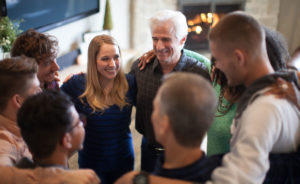9 Ways To Prevent Child Abuse In Your Children’s Ministry
Churches are not immune to child abuse. In fact, minors in churches can unwittingly become uniquely vulnerable to predators for many reasons. Churches and ministry leaders have a spiritual, moral, and legal responsibility to protect minors and the vulnerable from abuse.
This video is a sample from the TrainedUp video training library. It’s one module in a 9-part series designed to train volunteers on abuse prevention. Learn more about the TrainedUp Library.
Churches Are Spiritually And Morally Responsible
Before getting into the legal responsibility of churches when it comes to the wellbeing of minors, let’s talk about the spiritual responsibilities. Abuse is a spiritual and moral violation of God’s law and character.
The Bible is abundantly clear about God’s view of child abuse of any kind. Whether it’s sexual abuse, abuse of authority, or other mental or physical abuse, the Bible condemns it all. What’s more, we see Jesus’ approach to children when he valued their participation in his teaching and helpfulness in his ministry.
Abuse of any and every kind causes long term harm, often both physically and emotionally. And since those instances of abuse in churches often include someone in spiritual authority, long term spiritual harm is inflicted, as well. The harm caused to minors in these tragic and sinful incidents cannot be understated.
The primary and most important victim of abuse, and therefore the most important to protect, is the minor. But there are secondary victims of abuse in such cases. For example, whole families are harmed and scarred by abuse, church bodies lose trust for one another, and church organizations lose the trust of their communities.
The abuse of a minor is often the beginning of the end for many churches where such terrible events take place. It’s difficult, and many times impossible, for a church to continue to operate as a beacon of hope in a community where abuse has happened or been made possible by the leadership of the church.
Churches Are Legally Responsible
The responsibility of the local church organization extends to legal liability as well. Due to the increased risk of abuse in churches, some churches carry insurance that will cover court costs in case abuse occurs in their church body. However, the best insurance policy against the impacts of abuse is a thorough background check policy, a strong training program, and strict behavior policies for all volunteers who work with or near minors.
As they say, an ounce of prevention is worth a pound of cure. In this case, at least for the potential victims of abuse, more than an ounce of prevention is required.
Next, let’s look at some ways you can prevent child abuse in your church.
1. Background Check Policy
Every person who works with or near minors needs to complete a criminal background check. There can be no exceptions to this rule. Background checks that reveal a record of abuse or violence should be automatic disqualifications for working with minors.
My go-to provider of background checks for ministry is Protect My Ministry from Ministry Brands. It’s the simplest way to make sure your volunteers are cleared to serve with minors.
2. Two-Adult Policy
When working with minors, there should be two adults present whenever possible. In rare cases when two adults are not able to be present, there should always be an open door leading to where other adults are located.
3. Staff Supervision Policy
Church staff should be constantly or randomly checking in on volunteers working with minors. Oversight is vital in order to maintain accountability for volunteers to help them stick to ministry policies.
4. Parent Drop-off and Pick-up Policy
Parents should be given a note or sticker that matches a sticker on the child as proof that they were the parent that dropped off the child. If an adult attempts to pick up a child without the note/sticker, they can’t pick up the child.
One tool I have used and loved is Planning Center Check-Ins. It’s simple to use and easy to print matching stickers for kids and parents to ensure a safe pick-up experience.
5. Reasonable Restroom Policy
Two adults should, whenever possible, escort young children to the restroom. Once there, the adult(s) should not enter the restroom alone with a child. If a child needs assistance, the door to the restroom and stall must be left open and visible to another adult.
6. Discipline Policy
Never strike a child, use harsh language with a child, or threaten a child with abuse. Disciplinary action should be taken by the parent alone. If a child is acting out and timeouts or other non-physical discipline actions aren’t working, alert the parent immediately.
The best discipline is to prevent acting out by maintaining an orderly room.
7. Recognize Signs of Abuse
Minors who are being abused usually display signs that point to that abuse. Things like weight loss or gain, bags under the eyes, tiredness, unreasonable fear, resistance to touch, and extreme withdrawal from social interactions are some signs to look out for.
8. Treat All Abuse Reports Seriously
Every report of suspected or alleged abuse must be treated seriously. Always follow protocol for handling abuse reports, even if you are skeptical as to the truthfulness of the report. Victims must know they have a voice and will be believed.
9. Thorough and Proveable Safety Training for All Volunteers
Training volunteers on abuse-prevention policies is a good and necessary step. However, that training needs to be completely thorough, covering absolutely every aspect of abuse prevention. And, what’s more, that training needs to be proveable. That means church staff and outside auditors need to be able to see evidence that every volunteer has completed abuse prevention training. In just the same way that background checks need a record of proof, so does your training program.
TrainedUp automatically keeps a record of every person that completes training. With our done-for-you training course, Abuse Prevention for Children and Youth Volunteers, you’ll be ready to train and track volunteers with just a few clicks. This video course covers the following topics:
- Introduction to Child Abuse Prevention in Churches
- Sobering Statistics About Abuse
- Minors in Church Face Unique Risks
- Types of Child Abuse
- Supervision Policy
- Check-in and Restroom Policy
- Discipline Policy
- Background Checks
- Responding to Abuse
Get your abuse prevention training up-to-speed today with TrainedUp.
Train church volunteers and disciples online, easy.
Use our simple on-demand video training courses to equip volunteers, develop leaders, and teach disciples. Create your own training or use our video library. Our training automation platform makes it simple and fast to get your people ready for ministry.
Other Posts You May Like
All Growth Begins with Self-Awareness
My first year on the YouVersion Bible App team was exciting and challenging. I joined the team to help with partnerships and community-building. Like any new job, the first year came with a learning curve and the need to pick up new skills. I had never been part of a technology team before, so I…
Is Your Leadership Style Helping or Hurting You?
Your leadership style — how you make decisions, connect with and influence others, delegate, handle conflict, cast vision — is shaped by many factors. Your family history and work experience, along with your personality and internal wiring, impact how you think about and “do” leadership today. Leaders we have worked with, for better or worse,…
A Church Is Only As Healthy As Its Team
When you joined the team at your church, what kind of training did you get in the first weeks? Did you have an HR meeting to cover the health insurance and retirement accounts? Did you cover how to submit an expense report or reserve a room on the master calendar? How about how to handle…



